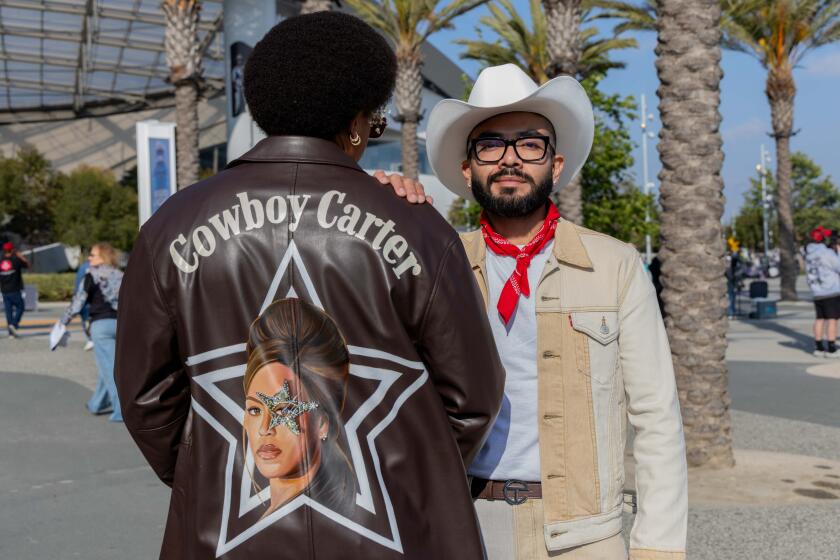What Reigns in Spain Isn’t Always Plain : Fashion: Designers put forth menswear for spring and summer that ranges from the classic and the sleek to the gaudy and the very extreme.
- Share via
BARCELONA — Spanish menswear for spring and summer 1991 is the most promising new entry on the international scene. The clothes are not unlike the famous architecture for which this city is noted--extraordinary in the extreme.
During the four days of shows that ended over the weekend, where 106 international exhibitors took part, styles tended to be as eccentric and excessive as Antonio Gaudi’s fantastical baroque structures of the 19th Century or as minimalist and modern as the stark and serene pavilion created by German-born Ludwig Mies van der Rohe for the 1929 Universal Exhibition here. That building stands adjacent to the Gaudi Hombre Trade Show where the menswear shows were held.
Like their Gaudi-created counterparts, some of the elaborately detailed menswear designs were often interesting and fun to look at. But it was the simpler, clean-lined clothes that seemed more practical for everyday life and potentially salable to the international retailers who can help cement Spain’s position as an important player in the world fashion market.
The strongest collection of the spring/summer season comes from Antonio Miro, one of Spain’s better established names in menswear. His ensembles are as sleek as a Mies skyscraper and could stand up against the big name designers in New York, Paris and Milan.
The Barcelona-born designer couples simple white linen, three-button jackets with cream, lightweight wool pants--a subtle and sophisticated combination of neutral tones and cool fabrics.
Pale green or blue seersucker sport jackets have knit collars. Check seersucker pants make a cool match with plaid cotton shirts--all in tones of beige and brown.
The new softer-shouldered, unconstructed silhouette that is an international trend in menswear is also a motif in Miro’s boxy-but-soft suits in aqua or blue-gray and for his totally unconstructed shirt jackets. He also does a great casual group of three-quarter-length sleeved, color-blocked shirts over solid, cropped-at-the-ankle pants (narrow legs are the new look) in tones of aqua, sky and marine--the shades you see in the Mediterranean off the coast of this port city.
David Valls, who refers to himself as “passionately Mediterranean,” says his spring/summer collection is influenced by the serenity of the sea.
Indeed, Valls’ line has the same clean, serene simplicity one found at Miro. A cream and tan group of ribbed cotton, button-front T-shirts and washed cotton pants opened the show. The tops are his “underwear as outerwear” approach to sportswear. He also does casual cotton knit or linen shorts that touch just below-the-knee for a new length. His drawstring-waist, button-fly, knit-cuffed pants are related to sweat clothes.
Valls’ quilt-stitched, hooded parka in linen is a neat twist on what is usually done as a winter item and slim-legged linen pants are sashed at the waist for a touch of subtle, Spanish spirit.
Jose Tomas’ collection is, oddly enough, almost too simple, soft and classic to be interesting. He works in the same shapes and soft shades of the season--sage, powder blue, mauve--but also scores with some brighter ideas including a brick linen jacket worn with orange velour sweat pants. A knee-length jumpsuit looks cool and comfortable, and Tomas turns a white linen tuxedo into sportswear by showing it with a removable formal collar and bib-front that revealed a T-shirt underneath.
A bit more on the Gaudi-gaudy side were the collections of Roser Marce, Gene Cabaleiro and Pepe Reblet.
Marce over-details much of her collection with oddly designed collars and lapels, elasticized waists, fabric-piercing, pocket flaps and button tabs that look more superfluous than ornamental. One pair of pants has a single suspender that only Li’l Abner could love.
But Marce does redeem herself with a playful starfish print for a sport jacket, in tomato and gray. A tricolor sport jacket in brown, gray and yellow and a group of shirts in a rainbow-hued Madras cotton, though decidedly colorful, look more controlled.
Gene Cabaleiro’s runway presentation resembled a costume epic with lots of Moroccan prints for shirts (a trend of the season), pants that wrap at the hip, lace tank tops, fabric inserts on everything (jeans with print fabric panels are all the rage in Ibiza, Spain’s version of St. Tropez) and evening spencer jackets that are sequined, embroidered and beaded. The draped viscose suits in bright colors would look wild even in a Las Vegas revue.
In all the collections, very wide-legged pants looked new. But Cabaleiro reaches too far with his pleated palazzos. His polo shirts and hooded tops with Venetian scenes or Renaissance paintings on the front, however, are great items for artful dressers.
There is “too much hot sauce” in the collection of Pepe Reblet where Lycra and lace make a big showing. A skintight jumpsuit with attached suede shorts sets the tone.
Armand Basi, probably the best-known name in Spanish menswear, falls somewhere between the gaudy and the austere. Chu Uroz who designs the Basi label, has carved a niche in international menswear with his sleek and sporty clothes often featuring geometric motifs. But he falls short this season with his Flash Gordon-esque looks--tight white pants with stitched-down creases and tight rayon T-shirts with stylized crown emblems sewn on. The resulting “space cadet” look seems anachronistic, rather than modern, and Uroz’s body-skimming, seamed sport jacket owes a lot to Paris modernist Thierry Mugler.
A sportswear label called Gusto Line was also one of the eight formal runway shows held during the Gaudi Hombre Trade Show. The clothes are fun and young and carry messages on T-shirts such as “No Drugs . . . But Jeans,” and “Less Fashion, More Passion.”
Oddly enough, none of the designers capitalized on Barcelona’s venue as the site of the 1992 Summer Olympics by doing related designs, although T-shirts celebrating the event are already on sale throughout the city.






